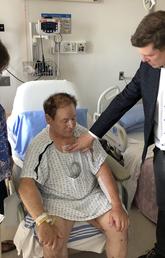May 31, 2021
High salt diet can help treat heart condition called POTS, researcher finds

Aisha Taylor, 24, knows what it is like to suffer with unexplained symptoms.
In Grade 9, she was diagnosed with mononucleosis and suffered with fatigue, difficulty exercising and dizziness. The then-athlete found herself breathing heavily while climbing stairs and getting sick for days after a workout with her school’s track team.
But even after recovering from mononucleosis, the fatigue and other symptoms persisted. Taylor also noticed that her heart wasn’t beating normally.
“I had an Apple watch and I remember my heart rate was 180 for hours at a time,” she says. “Even when I was lying down, it wouldn’t slow down.”
Over the next few years Taylor received numerous heart tests, including an echocardiogram, but no one could determine the cause of her high pulse rate, fainting and unwellness.
Although it was difficult, Taylor continued with her life, earning her undergrad degree and starting her master’s program in psychology at the University of Lethbridge. She also persisted in seeking answers for her illness. Then a cardiologist noticed Taylor rarely stood — or sat — completely upright. She often leaned or supported herself while in these positions.
He asked me if I was dizzy, and I thought, ‘What a silly question, everyone feels like this when they stand up. That’s when I began to realize that what I was feeling wasn’t normal.
That physician took her heart rate upon standing and noticed it increased. He suspected it might be postural orthostatic tachycardia syndrome (POTS), a condition that affects up to one per cent of the population, the vast majority young women of childbearing age. POTS causes a host of often-debilitating symptoms like fatigue, dizziness, tachycardia and fainting.
Taylor was referred to Dr. Satish Raj, MD, a cardiologist and researcher at the Libin Cardiovascular Institute at the Cumming School of Medicine, an internationally recognized expert in POTS, who diagnosed her with the condition.
The young woman was pleased to have a diagnosis after suffering for about eight years.
“It was a huge relief to know these weird symptoms aren’t in my head, there is a common cause for all of them,” says Taylor, explaining as a teenager, she often felt lazy for all the time she spent in bed.
High sodium diet and lots of water
Taylor is now on a regimen for her POTS that includes increasing her salt intake and drinking at least three litres of water per day.
The high sodium diet may be contrary to traditional ideas about heart health, but it’s a common treatment for POTS patients, says Raj. Until now, there were no studies proving its efficacy.
A study led by Raj on high dietary sodium intake in this patient group was published recently in the Journal of the American College of Cardiology.
“Historically, for a lot of autonomic disorders, and certainly POTS, our approach has been to try to increase blood volume by ‘filling the tank.’ We advise patients to drink lots of water and take lots of salt,” says Raj. “This study provides evidence that it does work.”
In previous work, Raj showed that individuals with POTS have a 12 to 13 per cent lower blood volume, on average, than their healthy counterparts.
“No one has really been able to discover why, but regardless, we know blood volume is low in these individuals,” says Raj.
A useful treatment
Participants in the study, which included individuals with POTS and healthy female participants, were placed on both low sodium and high sodium diets for one week. Researchers monitored their heart rate and levels of noradrenaline, a naturally occurring substance that regulates blood vessel muscle contraction and the force and rate of the heart’s contraction, in a standing and lying position.
Participants also rated their symptoms.
Raj’s team found that the high sodium diet in POTS patients led to an increase in blood plasma volume and a decrease in noradrenaline heart rate upon standing.
“It didn’t make a POTS patient look exactly like a healthy participant, but it brought them closer and is a useful treatment,” says Raj. “Their symptoms seemed to improve as well.”
Taylor is thankful to have finally found a treatment that eases some of her POTS symptoms, noting that when she adheres to the high sodium diet, she feels generally better.
“Overall this is really helpful for me,” says Taylor. “I feel a lot less nausea and fewer flu-like symptoms. I am not cured, but I am managing.”
This project was funded through the National Institutes of Health.
Satish Raj is a professor in the Department of Cardiac Sciences at the Cumming School of Medicine. He is also a member of the Libin Cardiovascular Institute.




